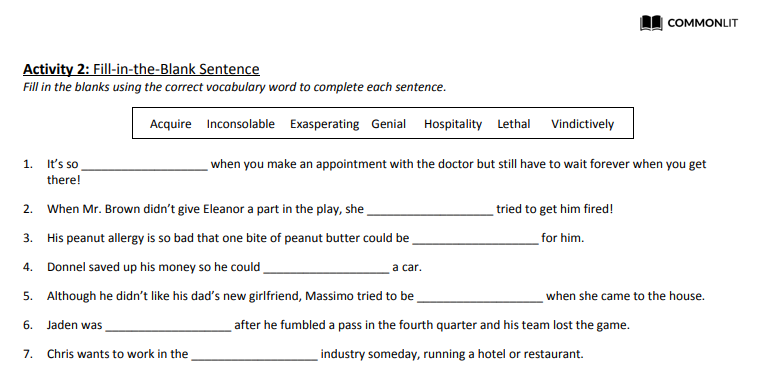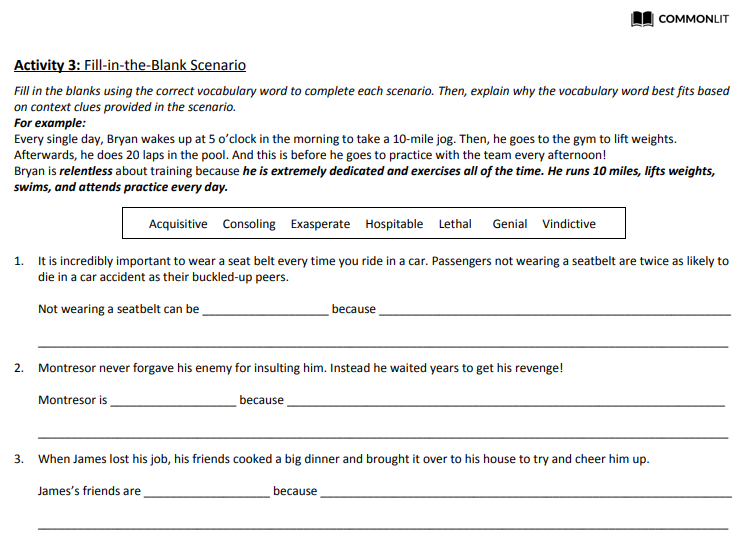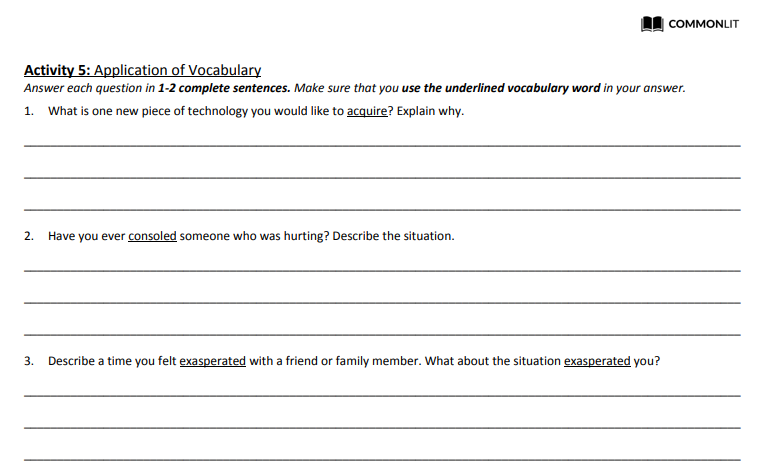As teachers, we know that it’s critical for our students to have a vast vocabulary. The more words that our students know, the more readily they’re able to read complex texts and write in a sophisticated manner.
Research supports this idea too; according to a recent study, “teaching vocabulary will not guarantee success in reading, just as learning to read words will not guarantee success in reading. However, lacking either adequate word identification skills or adequate vocabulary will ensure failure” (Biemiller, 2005).
Research also shows that it’s not enough for students to just memorize the definition of their vocabulary words. Instead, they need the chance to engage with each new vocabulary word multiple times and in several different ways (Stahl, 2005). More specifically, it’s critical that students apply these new vocabulary words in a variety of contexts (Stahl and Kapinus, 2001).

Since the research is so clear on the need for explicit vocabulary instruction, we have decided to make vocabulary a core component of our curriculum. In this blog post, I’ll break down what you should expect from our vocabulary materials and I’ll share some tips for efficiently utilizing these resources with your students.
The Basics
Each CommonLit unit will come with either one or two vocabulary packets. Included within each packet, our team has developed 5 activities for students to complete. Apart from the vocabulary packet, our team has also developed a short vocabulary quiz that you can download and print from the CommonLit Units page.
The words that we have chosen to include in our vocabulary packets are all Tier 2 words that appear in the texts of the given unit. By choosing Tier 2 words, students get the chance to master challenging grade-level words that they’ll likely see again in many different contexts.
The Vocabulary Activities
Each vocabulary packet included in the CommonLit curriculum includes 5 vocabulary activities. Below, I’ll briefly describe each activity and provide a few instructional tips:
Activity 1: In-Context Predictions

What Students Do: First, students should look at the picture on the right and read the caption below. After that, they should read the context sentence on the left and try to determine what the word means by making an inference. Then, they should complete the section that says “Definition prediction.”
Teacher Tips: After students have the chance to predict the definition, teachers should reveal the official definition for each word. Teachers can find this information on page 1 of the vocabulary packet.
Activity Length: Approximately 8–10 minutes for students to complete and 5 minutes to review
Why this Activity Is Important: By having students predict the meaning of each word prior to the teacher providing the definition, students get crucial practice determining the meaning of unknown words — an essential skill that all strong readers possess.
Activity 2: Fill-in-the-Blank Sentence

What Students Do: Students fill in the blanks using the vocabulary word that correctly completes the sentence.
Teacher Tips: You may choose to have students self-grade their work or grade a partner’s work. Since these words are still new to students, let them refer back to their notes from Activity 1 as needed. As an alternate option, teachers may choose to circulate around the classroom while students are working and identify the one or two words that students are struggling with. Teachers can then focus on reviewing those items with the class.
Activity Length: Approximately 5–10 minutes for students to complete and 2 minutes to review
Why this Activity Is Important: This activity gives students some practice seeing how the vocabulary words can be used in a sentence.
Activity 3: Fill-in-the-Blank Scenario

What Students Do: Students fill in the first blank with the vocabulary word that is most appropriate. Then, students explain why that vocabulary words fits the best by completing the scenario.
Teacher Tips: Teachers may choose to model the first vocabulary word with students. Teachers can show students how to choose the correct vocabulary word and then properly elaborate.
Activity Length: Approximately 10 minutes for students to complete and 2–4 minutes to review
Why this Activity Is Important: This activity is more rigorous than the previous activity. With it, teachers can see if students are able to apply an understanding of each word to a given scenario.
Activity 4: Matching

What Students Do: Students match the vocabulary word to its synonym.
Teacher Tips: This is great for a quick check. Feel free to have students self-grade their work, or swap with their neighbor for partner grading.
Activity Length: Approximately 5–8 minutes for students to complete and 1 minute to review
Why this Activity Is Important: This activity gives students the chance to match the vocabulary word to a more familiar vocabulary word. This helps students to see how words are connected.
Activity 5: Application of Vocabulary

What Students Do: Students answer each question and use the vocabulary word in context.
Teacher Tips: This is a harder activity for students to self grade. Teachers may choose to circulate around the classroom and spot check student work to ensure that students’ answers are on track.
Activity Length: Approximately 10–12 minutes for students to complete and 3–5 minutes to review
Why this Activity Is Important: This activity gives students the chance to use the word fully in context. If students can effectively utilize the vocabulary word during this activity, it’s very likely that this word is now a part of their vocabulary.
While the CommonLit team provides 5 great activities and a vocabulary quiz to help students learn new words, feel free to give students extra opportunities to utilize the words. For example, you can encourage students to use the new vocabulary words in their writing or you can have students create vocabulary flash cards so they can practice all of their vocabulary words throughout the school year.
How to Assign Vocabulary Activities
At CommonLit, we believe that there are several ways that vocabulary instruction can be effectively incorporated into classroom routines. Below, I’ll quickly explain our 3 favorite suggestions:
Option 1: Follow the Recommendations in the Unit
Included within each unit, the CommonLit team makes some recommendations as to when you can introduce each vocabulary activity. When we make these recommendations, we think about the overall pacing of the unit. When a unit has two vocabulary packets, our recommendations account for when students will encounter each word in their reading lessons.
If you find these recommendations helpful, feel free to use them!

Option 2: “Do Now” or “Bell Ringer”
Have students complete the next vocabulary activity in the packet every day at the very beginning of class. This activity is short and students can complete it as they settle in for class.
The vocabulary activities also repeat from unit-to-unit. As such, you won’t need to spend a lot of time explaining the directions. Students can just enter class and get right to work on an activity that should feel very familiar to them. This is a great way to build a strong classroom routine and ensure that class gets off to a smooth start every day.
Option 3: Nightly Homework Assignment
A similar option is to have students complete one activity per night as a homework assignment. This can help build strong homework routines with an activity that students should feel very comfortable completing.
When students come in the next day, you can quickly review students’ work on the homework, and then jump into the next lesson in the unit.
Conclusion
We’re so excited to continue supporting you and your students. If you have any questions or feedback about our vocabulary resources, don’t hesitate to email Pilots@CommonLit.org.


